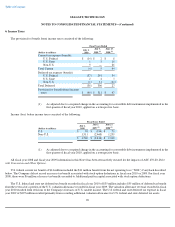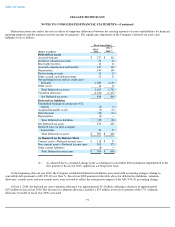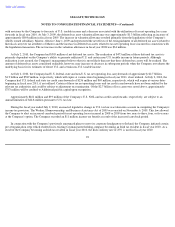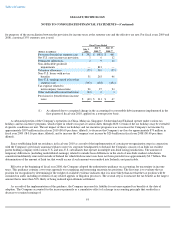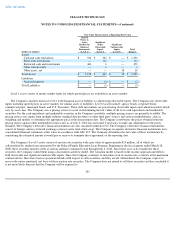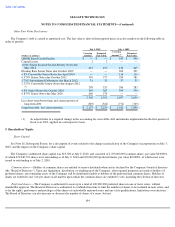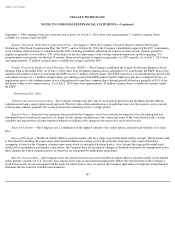Seagate 2009 Annual Report Download - page 105
Download and view the complete annual report
Please find page 105 of the 2009 Seagate annual report below. You can navigate through the pages in the report by either clicking on the pages listed below, or by using the keyword search tool below to find specific information within the annual report.
Table of Contents
SEAGATE TECHNOLOGY
NOTES TO CONSOLIDATED FINANCIAL STATEMENTS—(Continued)
The following tables show the effect of the Company's derivative instruments on OCI and the Consolidated Statement of Operations for the
fiscal year ended July 3, 2009:
8. Fair Value
Measurement of Fair Value
Fair value is defined as the price that would be received from selling an asset or paid to transfer a liability in an orderly transaction between
market participants at the measurement date. When determining the fair value measurements for assets and liabilities required to be recorded at
fair value, the Company considers the principal or most advantageous market in which it would transact and it considers assumptions that market
participants would use when pricing the asset or liability.
Fair Value Hierarchy
A fair value hierarchy is based on whether the market participant assumptions used in determining fair value are obtained from independent
sources (observable inputs) or reflects the Company's own assumptions of market participant valuation (unobservable inputs). A financial
instrument's categorization within the fair value hierarchy is based upon the lowest level of input that is significant to the fair value
measurement. The three levels of inputs that may be used to measure fair value:
Level 1—Quoted prices in active markets that are unadjusted and accessible at the measurement date for identical, unrestricted assets or
liabilities;
Level 2—Quoted prices for identical assets and liabilities in markets that are inactive; quoted prices for similar assets and liabilities in
active markets or financial instruments for which significant inputs are observable, either directly or indirectly; or
Level 3—Prices or valuations that require inputs that are both unobservable and significant to the fair value measurement.
98
(Dollars in millions)
Derivatives Designated as Cash Flow
Hedges under ASC 815
Amount of
Gain or
(Loss)
Recognized
in OCI on
Derivative
(Effective
Portion)
Location of Gain
or (Loss)
Reclassified
from
Accumulated
OCI into
Income
(Effective
Portion)
Amount of
Gain or (Loss)
Reclassified
from
Accumulated
OCI into
Income
(Effective
Portion)
Location of Gain
or (Loss)
Recognized in
Income on
Derivative
(Ineffective
Portion and
Amount
Excluded
from
Effectiveness
Testing)
Amount of
Gain
or (Loss)
Recognized in
Income
(Ineffective
Portion and
Amount
Excluded from
Effectiveness
Testing)
(a)
Foreign currency forward
exchange contracts
$
(24
)
Cost of
revenue
$
(36
)
Cost of
revenue
$
(1
)
Derivatives Not Designated as Hedging Instruments under ASC 815
Location of Gain or
(Loss) Recognized in
Income on Derivative
Amount of Gain or
(Loss) Recognized in
Income on Derivative
Foreign currency forward exchange contracts
Other, net
$
(18
)
Total return swap
Operating expenses
(1
)
$
(19
)
(a) The amount of gain or (loss) recognized in income represents $0 related to the ineffective portion of the hedging
relationships and $(1) million related to the amount excluded from the assessment of hedge effectiveness, for the fiscal
year ended July 3, 2009, respectively.



